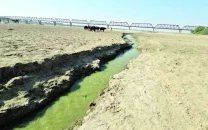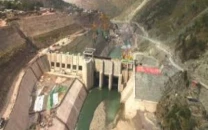Benazir Income Support Programme: Does the cash flow to blue-eyed voters?
Lawmakers accuse govt of using BISP as a political tool: The Express Tribune looks at data, and weighs arguments.

Benazir Income Support Programme: Does the cash flow to blue-eyed voters?
The numbers don’t make sense at first glance.
Punjab, with more than twice the population of Sindh, has two-thirds of the number of families considered eligible for income support in the latter.
Multan, the prime minister’s hometown, has almost half the population of Lahore, stronghold of the opposition Pakistan Muslim League-Nawaz (PML-N), yet has twice as many families receiving Rs1,000 monthly stipend from the government.
The apparent anomalies have led to resentment, and accusations of nepotism, not just from the opposition, but government’s allies too.
Lawmakers say that districts and constituencies considered strong-hold of the ruling Pakistan Peoples Party have a disproportionately high number of people considered eligible for cash handouts.
The opposition openly accuses the government of using the Benazir Income Support Programme (BISP) as a political tool since its inception in 2008.
Many lawmakers are also questioning the authenticity of a Rs5 billion poverty survey conducted by the BISP last year. The results of the country’s ‘first ever’ poverty survey have yet to be made public.
Provincial data
When the BISP official data, available with The Express Tribune, is plotted on a provincial map, the findings lend credence to opposition’s claims at first glance.
Punjab, the most populous province but ruled by the opposition PML-N, has the lowest ratio of beneficiary families – 1,974 families per 100,000 people – of the four federating units. Sindh, the stronghold of PPP, has three-and-a-half times that ratio – 6,829 families per 100,000 people.
Khyber-Pakhtunkhwa and Balochistan, where PPP is part of coalition governments with its allies – the Awami National Party (ANP) and the Pakistan Muslim League-Quaid (PML-Q) – trail Sindh with 5,155 and 4,858 beneficiary families per 100,000 people respectively.
Both Gilgit-Baltistan, an autonomous territory, and Azad Jammu and Kashmir, a self-governing state, have governments aligned with the ruling PPP and have 2,400 and 1,518 beneficiary families per 100,000 people receiving income support respectively.
Constituency-level data
A closer inspection at some of the districts further corroborates the opposition’s suspicions. Districts where the ruling party or its allies have majority of the constituencies (coloured blue in the corresponding map), fare better than where the opposition holds sway (coloured red).
District-wise ratios of beneficiary families to per 100,000 people are also given.
Counter-evidence
When asked about apparent disparity in the data, a BISP spokesperson said that given the socio-economic variance across the country, the number of BISP beneficiaries is not proportionate to the population of any district.
“Poverty scorecard is a scientific instrument and it identifies eligible families based on their poverty score, rather than any other consideration” said the spokesperson in a written reply.
The programme declares those eligible for Rs1,000 monthly income support who score less than 17, out of a total 100 points, in the Poverty Targeting Survey Programme (PTSP).
Poverty varies in different cities according to distribution of resources – hence the poverty level in Thar cannot be compared with that of Lahore, Rajanpur cannot be compared with Rawalpindi and Benazirabad cannot be compared with Karachi, he added.
A cross-check with district-wise Human Development Index (HDI) scores, a standard means of measuring well-being globally, lends at least some credence to the spokesperson’s claim. Punjab has a higher HDI compared to other provinces while Karachi and Lahore, which has a low ratio of beneficiary families compared to Multan, have the highest HDIs amongst the districts compared. There are anomalies, though, like Khairpur and Larkana.
Contracts to survey firms
The BISP spent Rs5 billion on the poverty survey, the PTSP. Of this, Rs2.5 billion have been given to organisations conducting the survey and Rs1.75 billion to post offices. The programme owes Rs733 million to these organizations in lieu of the exercise.
The survey was largely conducted by the Rural Support Programme Network – in Upper Punjab, AJK, Sindh, K-P and G-B. Other independent firms were contracted for surveys in southern Punjab and Fata while the Population Census Organisation was awarded the contract for Balochistan survey. The government’s allies are raising questions over the survey.
“I questioned the procedure adopted by the BISP for awarding contracts for PTSP and details of amount paid to each organisation for survey but they never replied, which is a breach of lawmakers’ rights,” said ANP Senator Zahid Khan.
Terming the survey “as controversial as the BISP,” Khan said that several senators will move against the BISP in the courts [for] rampant corruption and nepotism.
The programme awards all contracts using the World bank’s guidelines for ‘quality and cost based selection’ of these firms, said the BISP spokesperson.
It is a very rigorous process and the BISP secured World Bank’s approvals at every stage of the award of process, he added.
Published in The Express Tribune, February 4th, 2012.

















COMMENTS
Comments are moderated and generally will be posted if they are on-topic and not abusive.
For more information, please see our Comments FAQ